Coronavirus Mind Mapping with Jessica Hamilton-Jones
Description
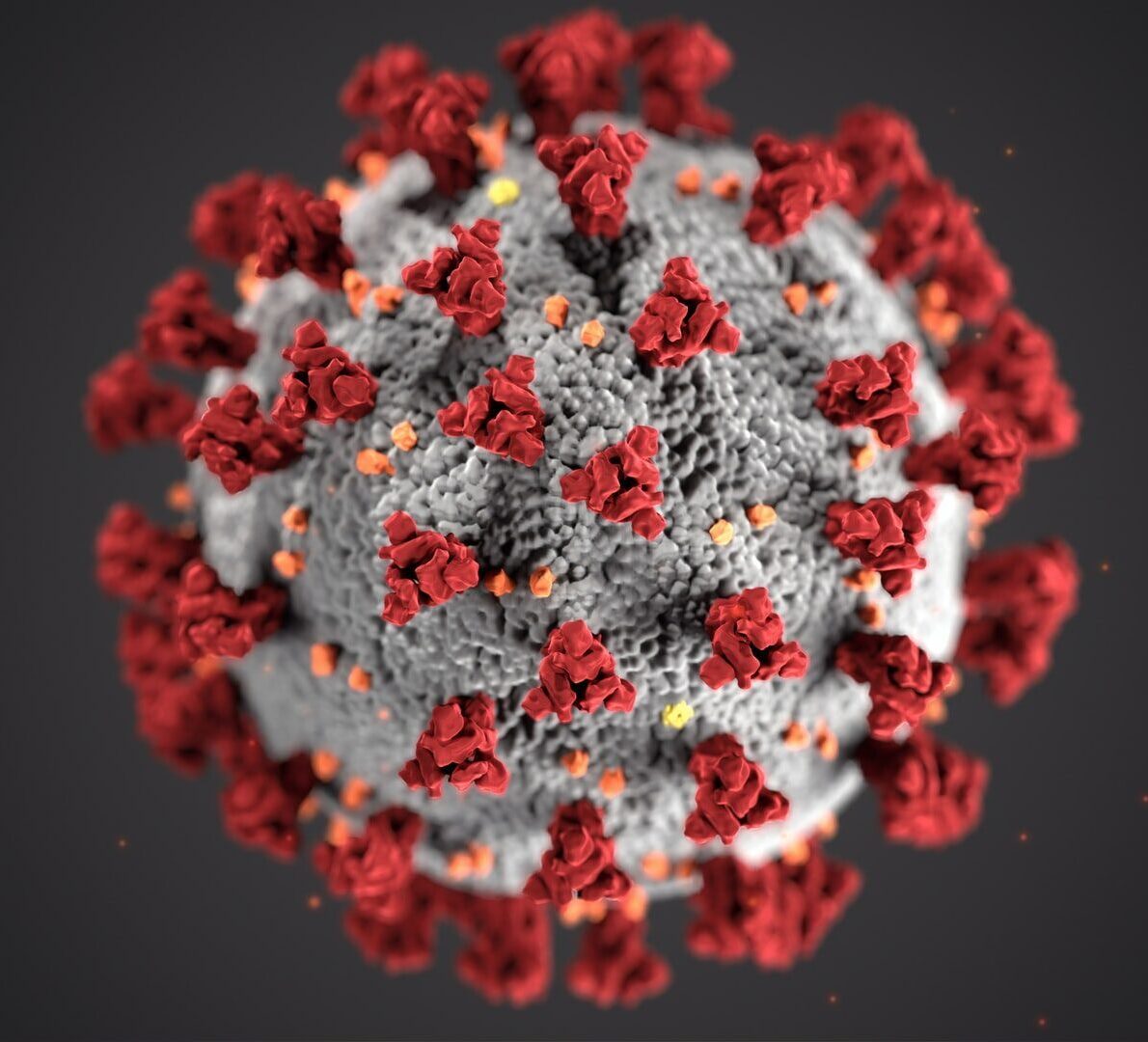
This was a mixed media workshop that focused on “mind mapping” of personal experiences during the coronavirus pandemic. Students used drawing, painting and photographs to create a self-portrait or personal representation of themselves in the center of the piece. Once the base was sketched out, they incorporated images, colors, and other materials to illustrate the words and feelings generated from their experience of the pandemic. The finished products resembled the coronavirus with spikes that reflect various aspects of the pandemic.
Instructor Bio
Jessica Hamilton-Jones (she/her) is art teacher at the Waterville Alternative High School and a proud mom of four kids. She graduated from Pratt Institute in Brooklyn, N.Y in 1989. She was a resident artist at the Vermont Studio School, and worked at Philips Academy in Massachusetts and the Hampton Day School in Long Island. Returning to Maine in 2008, Jessica opened a small florist shop and gallery. While attending UMA, Jessica became a museum educator at the L.C. Bates Museum, teaching kids of all ages to catch and draw frogs. As fun as that was, her happiest times are now spent side by side with her at-risk students making incredible art.
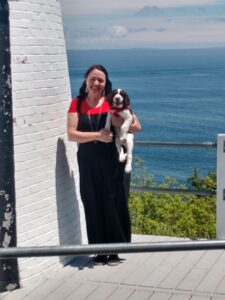 Artist’s Statement
Artist’s Statement
During a time of crisis, the more we can shift out of our heads and into our bodies, the more grounded we will feel. Creating art has the power to do just that. Becoming creators of culture gives us agency and purpose and reflects our identity and the community in which we live. With the self-portrait as the central focal element of each artist’s piece, and their experiences and perceptions of the community sprouting all around them, this artwork will deliver a powerful visual message that communicates a new perspective on this time in the history of Maine.
Workshop Results
This essay is by workshop instructor Jessica Hamilton-Jones.
I chose to model a creative mind map because it was an efficient way to get a bunch of jumbled ideas and thoughts out of your head and onto paper. I also thought the general mind map format of a central circular theme with smaller ideas radiating out visually resembled a coronavirus. I wanted the central image to be a self-portrait to keep the focus on their personal experiences. I also included an outline of the state of Maine to help them think about their experience from the perspective of a Mainer. My own coronavirus mind map (figure 1) was used to help inspire participants as they created their own versions.
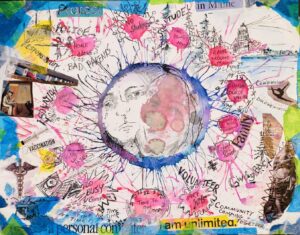
The workshop began with a series of questions to help participants think about the subject. They entered their answers in a very simple form onto a graphic organizer of a mind map that I handed out to them. Some of the questions included: Who has helped you the most during the quarantine? Did you have to take on a responsibility that you couldn’t handle? Since the pandemic, do you spend more or less time with electronic devices? What would an alien think about Maine if they were to visit right now?
Now that they had some of their thoughts gathered, they could begin their art piece. My only guidelines were (a) to have something that represents them in the center, and (b) to keep to the theme of the coronavirus and how it has affected them.
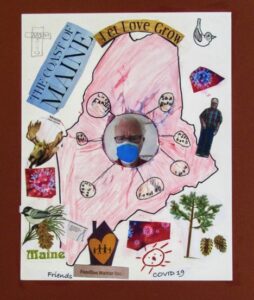
My first workshop was with a group of clients from Families Matter, Inc., a non-profit organization supporting young adults with special needs in the Waterville area, and their families. I chose to work with this group because their opinions are often overlooked by the larger society. As we talked about the many issues that have come with this pandemic, I could tell that this group was clearly upset, worried, and even angry about all of the things that have changed. Interestingly, this group was most concerned for others rather than themselves.
We also talked about living in Maine during the pandemic. Other than one participant who has family in Florida and travels back and forth, all were Maine residents. Everyone was glad they were Mainers and enjoyed thinking about things that are special about Maine. As Figure 2 shows, many of these artists used images of Maine in their work.
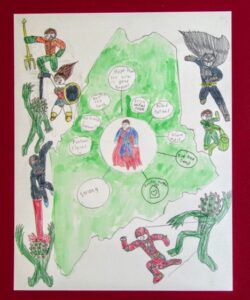
Others in this cohort focused on their own strength and how it was helping them to cope with the pandemic. In Figure 3, for example, a young man named Peter showed himself as a superhero, and his mind map showed him and others fighting virus-headed monsters.
One of my questions to these adult artists was, “What is giving you hope right now?” I was glad I asked this, because it helped everyone focus on positive things and how they can make decisions that will make the future better. At the end of the workshop, I asked if they enjoyed the project. My heart soared at their answer: that this project helped them to feel much better about the current situation.
I also conducted a workshop with several teenagers from Waterville. Isolation was a prevalent theme in their art, as was the increased time spent on electronic devices and playing video games. Just like the Families Matter artists, this cohort includes adamant fighters for justice, some of whom were concerned about people who neglected to wear a mask.
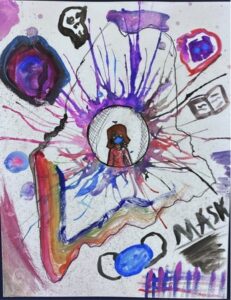
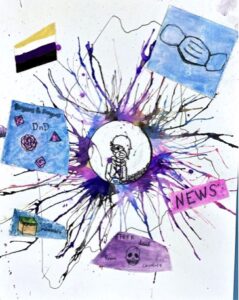
You can see this theme in Figures 4 and 5, mind maps from sisters Reagan and Maya Lavallee (both aged 13), where their self-images in the center of the paintings resemble characters from graphic novels. Both are wearing masks, and images of masks are found elsewhere in their paintings. Clearly this symbol has become integrated into how they see themselves during the coronavirus pandemic, and how they see those around them. It is interesting to see how art can help identify the things that are now becoming part of our culture and day-to-day lives.
The metaphor of the Jack Pine seedling emerging from the ashes fit wonderfully with this project. All of the participants revealed things that they were worried about, scared about, upset about, or anxious about. They talked about how the pandemic has created changes and barriers in their daily lives. At the same time, it was inspiring to see that every participant had found some silver linings, and that their first concerns were for the health and safety of others. Their hardy Maine spirit showed through this art project, as they have all courageously made changes and are all fighting in their own ways to make things better. They are all stronger from this pandemic and emerging like the seedling from the ashes.
